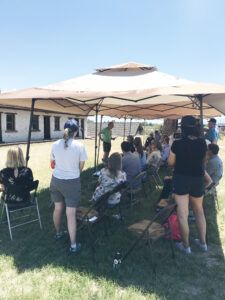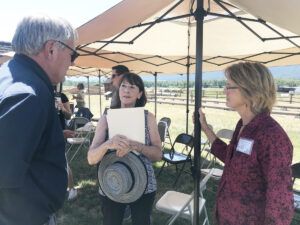A celebration was held last Wednesday, June 30 at Fort Owen State Park in Stevensville to mark the official reopening of the park. The historic site has come a long way from the situation several years ago when the state had actually considered closing the tiny but significant park. Today the east barracks has a new roof, a parking lot has been developed on land recently acquired just to the south of the park, and a $500,000 grant has been secured to continue to make needed improvements to this important remnant of, and monument to, Montana’s early history.
Randy Arnold, Fish, Wildlife and Parks Regional Supervisor for Region 2, said he wanted to pull everyone together who helped to make this happen and to celebrate.

Owen. Photo by Victoria Howell.
“I’ve been looking forward to this for a long time,” said Arnold. He especially thanked Myla Yahraus, the owner of the Fort Owen Ranch, a private ranch that surrounds the state park and also included the unofficial fishing access site at the Bitterroot River on the west edge of her property just north of the Stevensville bridge. Arnold said that Yahraus deserves credit for “all her hard work and cooperation.”

From first taking over the ranch, Yahraus expressed an interest in the history of the site and a desire to see it preserved and utilized in a way that would take into consideration her own need for clear boundaries between the public and private spaces. She has stayed in contact with the local Friends of Fort Owen group since buying the ranch and has allowed them to use her facilities on occasion.
Arnold said that the public has been accessing the river there for many years. “It was a very complicated situation,” he said. Until now. Yahraus has donated a 6.25-acre piece of land to the state for an official fishing access site and the ownership has now officially changed hands.
“The community always saw the bridge access site as their fishing access site,” said Arnold. “The former owner [before Yahraus] got weary, very weary,” dealing with trespassing, garbage and other issues.
Arnold said he got a call from the late Dale Burk who alerted him to the change in ownership and that there “could be a real opportunity here.”
(Burk was a well-known sportsman, journalist, author, environmental activist, and a founding member of Friends of Fort Owen. He was extremely concerned about both history and public access.)
Reflecting on the Fort Owen historic site, Arnold said, “When you look at this site, you wonder, where’s the investment… I think this is the beginning of a new trajectory.”
Loren Flynn, Park Manager for Montana Fish, Wildlife and Parks Region 2, said that the Salish called this “The Place of White Cottonwoods” and said there “is no dispute about the importance of this site.” It is a place of firsts, he said, in the story of Montana’s development, the first grist mill, the first sawmill, the first agriculture, the first water rights.
“We have a lot of work to do here but it does feel like we’ve changed the trajectory,” said Flynn.
Flynn also thanked Yahraus for her involvement, as well as many of his colleagues in FWP who helped on the project. He also mentioned the Stevensville community and the Friends of Fort Owen. “They were the genesis of starting the conversation on this.”
Mike Volesky, FWP Chief of Operations, reminded the audience that Salish history is also a major part of the story of this area, with many “firsts” as well: the first treaties, the first reservations, the first baptisms, the first forced removals, etc.

“Folks were here for 10,000 plus years before we came along,” said Volesky. Flynn said later that the Salish are being consulted regarding how they would like their information to be included in any interpretive information or exhibits at Fort Owen.
Volesky noted that the Stevensville Historical Society, a group that held title to Fort Owen and no longer exists, deserves credit for turning the property over to the state of Montana.
Flynn said they are now working on repair of the adobe and other preservation work inside and out. They will also be hiring a consultant to develop an interpretive plan which will be implemented over multiple years.
“The Friends of Fort Owen are excited to see the improvements being made at the park,” said Margaret Gorski, President of the Friends group. “We have worked hard to show how important Fort Owen is not only for its historic significance but as an educational and tourism asset to Stevensville, the county, and the state. We look forward to seeing new programs and events at the park now that we have a place for visitors and buses to park!”
In regards to the fishing access site, Arnold said the conceptual plan for the site is about 75% completed. He said the state has the money to develop the site but the permitting required – for the latrines, for example – will take some time. The site will include parking spaces for cars and trailers, some tree planting and erosion prevention measures, and even some primitive campsites. He expects the development of the site will probably take place in 2022. Yahraus has suggested “John Owen Fishing Access Site” for the name.